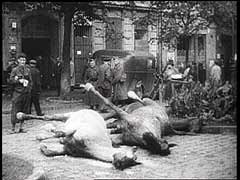You searched for: 酒类推广平台【TG飞机:@bapingseo】YouTube全世界推广开户【TG电报:@bapingseo】西撒哈拉最大的灰产社群【Telegram:@bapingseo】捕鱼海岛下载飞艇6码买前6加拿大28大神最新版本?5rYshm/333760.html
<< Previous | Displaying results 351-375 of 589 for "酒类推广平台【TG飞机:@bapingseo】YouTube全世界推广开户【TG电报:@bapingseo】西撒哈拉最大的灰产社群【Telegram:@bapingseo】捕鱼海岛下载飞艇6码买前6加拿大28大神最新版本?5rYshm/333760.html" | Next >>
-
Aftermath of pogrom in Iasi
PhotoRoma (Gypsies) remove bodies from the Iasi-Calarasi death train during its stop in Tirgu-Frumos. Two trains left Iasi on June 30, 1941, bearing survivors of the pogrom that took place in Iasi on June 28-29. Hundreds of Jews died on the transports aboard crowded, unventilated freight cars in the heat of summer. Romania, July 1, 1941.
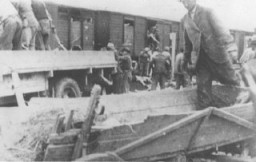
-
1945 portrait of Eta Wrobel
Photo1945 portrait of Eta Wrobel who was born on December 28, 1918, in Lokov, Poland. During the Holocaust, Eta helped organize an exclusively Jewish partisan unit of close to eighty people. She was the only child in her family of ten to survive.
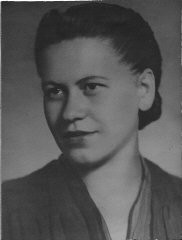
-
Photo taken a few weeks before World War II began
PhotoPhoto taken a few weeks before World War II began. Regina is at the right of the front row. Kunow, Poland, July 28, 1939.

-

-
Mechelen
ArticleThe Mechelen camp, halfway between Antwerp and Brussels, was a transit camp for the deportation of Jews from Belgium during the Holocaust.

-
Kamenets-Podolsk
ArticleIn August 1941, Kamenets-Podolsk became the site of a mass killing of Jews. This was one of the first large-scale mass murders of the Final Solution.

-
Refugee camp in Zbaszyn
PhotoView of Zbaszyn, the site of a refugee camp for Jews of Polish nationality who were expelled from Germany. The Jewish refugees, hungry and cold, were stranded on the border, denied admission into Poland after their expulsion from Germany. Photograph taken between October 28, 1938, and August 1939. Warsaw-based historian, political activist, and social welfare worker Emanuel Ringelblum spent five weeks in Zbaszyn, organizing assistance for the refugees trapped on the border.
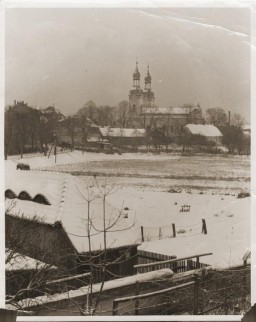
-
View of the refugee camp in Zbaszyn
PhotoView of the flour mill in Zbaszyn, which served as a refugee camp for Jews expelled from Germany. The Jewish refugees, hungry and cold, were stranded on the border, denied admission into Poland after their explusion from Germany. Photograph taken between October 28, 1938, and August 1939. Warsaw-based historian, political activist, and social welfare worker Emanuel Ringelblum spent five weeks in Zbaszyn, organizing assistance for the refugees trapped on the border.

-
Destruction of the Lodz Ghetto
Timeline EventBeginning on August 9, SS and police units liquidate the Lodz ghetto.
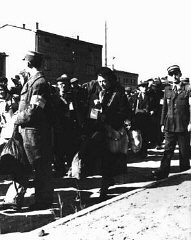
-
Germany invades Poland
FilmGermany invaded Poland on September 1, 1939, beginning World War II. Quickly overrunning Polish border defenses, German forces advanced towards Warsaw, the Polish capital city. This footage from German newsreels shows German forces in action during the invasion of Poland. Warsaw surrendered on September 28, 1939.
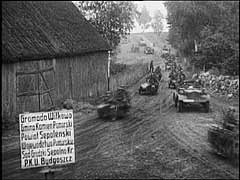
-
Polish Jews in Lithuania: Escape to Japan
ArticleAfter 1940, Polish refugees were pressured to leave Lithuania. Learn more about the diplomats that assisted them and their journey to Japan.
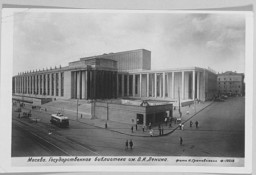
-
Eleanor Roosevelt
ArticleEleanor Roosevelt, longest serving First Lady in US history, used her social and political influence to intervene on behalf of refugees before and during WWII.
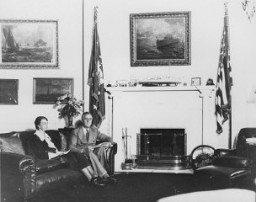
-
Mauthausen
ArticleThe Mauthausen concentration camp was established following the Nazi incorporation of Austria in 1938. Learn about the harsh conditions in the camp.

-
Wool Bedcover
ArtifactFollowing the Soviet occupation of Lithuania, the Lifszyc family began to search for ways to leave the country. David Lifszyc obtained a Curacao visa from the Dutch consulate. He also obtained an American visa because he was included on a list of distinguished rabbis submitted to the State Department by the Agudat Israel of America. After obtaining Soviet exit visas, the Lifszycs purchased tickets for Vladivostok on February 5, 1941. They started for Moscow, where they received Japanese transit visas. This…
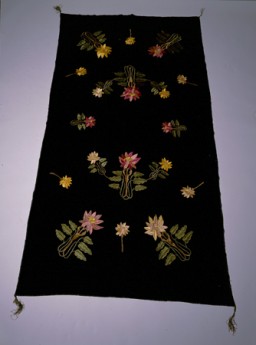
-
Beifeld album page illustrating fortifications and first fatality
Artifact(Bottom) View of fortifications built at Kalimovka to defend the advancing troops of the 4th Infantry Division of the Hungarian 2nd Army. In the lower right corner of the drawing, men prepare the grave of Jewish Labor Serviceman Nandor Klein, the first fatality of the company. The Hungarian caption reads: The death of our first hero, Nandor Klein, his grave, June 5, 1942." Klein was killed by a stray Soviet bullet on his way back to base. [Photograph #58013]

-
Adolf Hitler greets Paul von Hindenburg
PhotoRecently appointed as German chancellor, Adolf Hitler greets President Paul von Hindenburg in Potsdam, Germany, on March 21, 1933. This pose was designed to project an image of Hitler as non-threatening to the established order. This particular image is from a popular postcard. The photo also appeared widely in both the German and international press. Hitler appears in civilian dress, bowing in deference to the heavily decorated von Hindenburg. The March 5, 1933, elections had conferred legitimacy on…
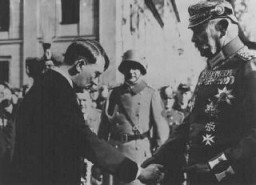
-
Two young brothers in the Kovno ghetto
PhotoTwo young brothers, seated for a family photograph in the Kovno ghetto. One month later, they were deported to the Majdanek camp. Kovno, Lithuania, February 1944. Pictured are Avram (5 years) and Emanuel Rosenthal (2 years). Emanuel was born in the Kovno ghetto. The children, who were deported in the March 1944 "Children's Action," did not survive. Their uncle, Shraga Wainer, who had asked George Kadish to take this photograph, received a copy of it from the photographer after the war in the Landsberg…
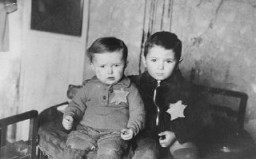
-
Hainichen
ArticleIn 1933, the Nazis established the Hainichen labor camp in Sachsen, Germany. Learn more about the camp, its closing, and the prisoners.
-
Theresienstadt: Other Prisoners
ArticleLearn more about the fate of Jewish prisoners that were deported to Theresienstadt from places other than the Greater German Reich or the Protectorate.

-
Subsequent Nuremberg Proceedings, Case #3: The Justice Case
ArticleThe Justice Case was Case #3 of 12 Subsequent Nuremberg Proceedings against leading German industrialists, military figures, SS perpetrators, and others.
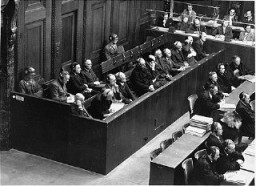
-
Bernard Druskin
ArticleRead the Jewish Partisan Educational Foundation's short biography of Bernard Druskin.
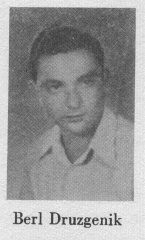
-

-
Police maintain watch outside the Eldorado nightclub, long frequented by Berlin's gay and lesbian community.
PhotoPolicemen stand outside the shuttered Eldorado nightclub, long frequented by Berlin's gay and lesbian community. The Nazi government quickly closed the establishment down and pasted pro-Nazi election posters on the building. Berlin, Germany, March 5, 1933. Learn more about this photograph.

-
The 26th Infantry Division during World War II
ArticleThe 26th Infantry Division participated in major WWII campaigns and is recognized for liberating the Gusen subcamp of Mauthausen in 1945.
-
Fall of Warsaw
FilmGerman troops reached parts of Warsaw on September 8 and 9, 1939. During the German siege of Warsaw, the city sustained heavy damage from air attacks and artillery shelling. Warsaw surrendered on September 28. Here, German troops occupy Warsaw. This footage comes from "Tale of a City," a film made by a Polish underground film unit.
